Contents
- Boosting demand key for economic revival
- Pancharatra Agama
- Long-Awaited DSDBO Road Now Upsets China.
- India demands restoration of Pre-standoff status along LAC
- Due to Lockdowns Census-NPR may be pushed to 2021
- Plans Afoot for India’s 1st Coal Exchange
BOOSTING DEMAND KEY FOR ECONOMIC REVIVAL
Focus: GS-III Indian Economy
Why in news?
- The actual fiscal spending involved is much lower than the Economic Stimulus package which is said to amount to over ₹20 lakh crore (10% of GDP)
- The reason for this is that two-thirds of the package is focused on credit infusion programmes.
- This implies that supply side measures such as easing credit supply are unlikely to help boost the economy, although some businesses may benefit from it.
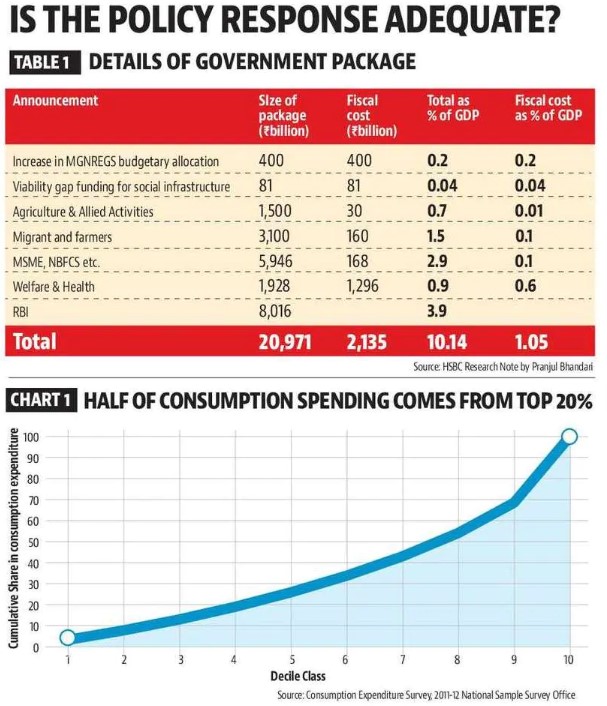
Where does demand come from?
In a modern economy, demand comes from three sources:
- domestic consumption
- exports
- investment.
Imports represent negative demand, as local purchasing power is diverted towards foreign goods.
Export issues
With the multilateral trading regime in jeopardy, rise of protectionism and trade wars and shock of the pandemic, exports are unlikely to revive anytime soon.
Another factor which will prevent an export surge is India’s inability to join any major regional trade treaty.
Domestic Consumption
Private Final Consumption Expenditure has had a share of almost 60% of India’s GDP in the recent period. India’s private spending is very unequal in nature. An analysis of 2011-12 NSSO data (latest available figures) shows that almost half of it came from the top 20% of the population.
Income Inequality
An analysis of income tax data shows that 90% of income taxes in India came from the top 5% of the 50 million who even file income tax returns.
Issue with Boosting Consumption Demand
Precautionary savings tend to rise under conditions of income uncertainty.
There is thus a strong likelihood that the income uncertainty people are experiencing right now will nudge Indian households to increase precautionary savings at least for the next few years.
Investment as a driver of growth
Demand for capital goods is a derived demand; unless businesses see future growth in domestic demand or exports, they will not invest.
The concept of paradox of thrift
The concept of paradox of thrift developed by John Maynard Keynes says that if everybody were to start saving more in an economy, aggregate demand would go down. This will lead to lower incomes. Because savings are a fraction of income, collective savings will go down as well.
Way Forward: What can be done?
Food Security
- NSSO data shows that at least half of India’s population spent half of its budget on food – hence, a rise in food prices hurts the poor.
- There is merit in focusing on the bottom 80% of the population.
- An expansion of the current food security programme could benefit both farmers and consumers.
- One such way could be allowing employment of MGNREGS workers in private agricultural activity.
Health and Education
- Another area where things can be changed in the medium to long term is health and education services.
- In India, even the poor spend beyond their means on private education and healthcare.
Investment in food security, health, education etc. is generally seen as a resource diversion from physical infrastructure which directly promotes growth.
State spending in the food economy and social sector, even with stagnant or slightly lower wages, could free up a greater amount for spending by the poor in the non-farm economy.
-Source: Hindustan Times
PANCHARATRA AGAMA
Focus: GS-I Art and Culture
Introduction
- Temples like Srirangam and the Varadaraja temple in Kanchi are governed by the Pancharatra agama.
- Ratra denotes ajnana, and pancha denotes that which destroys ajnana.
- Lord Narayana has five forms — Para, vyuha, vibhava, antaryami and archa — and hence the name Pancharatra.
- Ratra also means jnana (knowledge).
- Jnana is of five types, and this is called artha panchakam.
- Ahirbuddhnya Samhita says the qualities of the five forms of Vishnu are described in the Pancharatra agamas, and that is why they are so called.
- The Divya Prabandham abounds in pasurams, where Vishnu is referred to as koothan (dancer).
- The Pancharatra Agamas make it clear that dance is an important part of worship in Vishnu temples.
What is Pancharatra Agama?
- The “Pancharatra Agama” is one of the religious texts that describe practical and theoretical concepts for those who follow the Hindu school of philosophy known as Vaishnavism.
- Although there are believed to be more than 200 Vaisnava agamas, the “Pancharatra Agama” is thought to be the most authoritative by many scholars.
Pancharatra
- Pancharatra was a religious movement in Hinduism that originated in late 1st millennium BCE around the ideas of Narayana and the various avatars of Vishnu as their central deities.
- The movement later merged with the ancient Bhagavata tradition and contributed to the development of Vaishnavism.
Agamas
- Agamas are a special class of Hindu religio-philosophical literature handed down through a succession of teachers from the most ancient days.
- Of the three kinds of Agamas, the Saiva, the Sakta (or the Tantra) and the Vaishnava.
-Source: The Hindu
LONG-AWAITED DSDBO ROAD NOW UPSETS CHINA
Focus: GS-III Industry and Infrastructure, GS-II International Relations
Why in news?
Darbuk-Shyok-Daulat Beg Oldie (DSDBO) road joining Leh to the Karakoram Pass has been in the making for around two decades and is expected to be completed by 2020.
Details
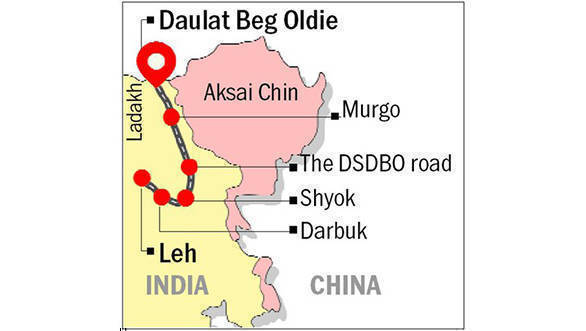
- The road from Darbuk traverses at an altitude of 14,000 feet and reaches Shyok, the last Indian village in the region.
- Between Shyok and Karakoram Pass (that divides Ladakh from China’s Xinjiang province) lies Daulat Beg Oldie (DBO).
- From the DSDBO road, a road branches off towards Galwan Valley, a hill feature, which India wants to protect because it overlooks the area around the main road. The branch road has prompted the stand-off in Galwan Valley.
Significance of DBO
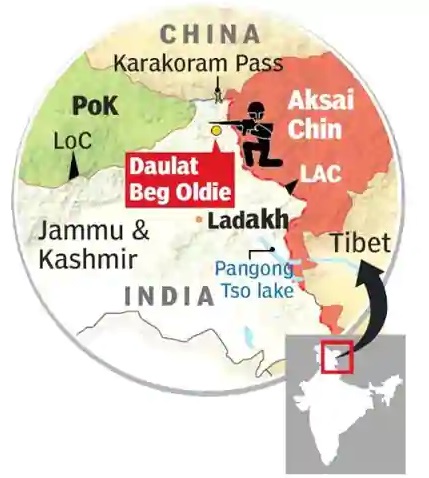
- Daulat Beg Oldie (DBO) is a historic campsite and current military base located on an ancient trade route connecting Ladakh to the Tarim Basin.
- DBO is on a plateau at an altitude of over 16,000 feet and is the location of an Advanced Landing Ground (ALG) used by the air force to drop supplies.
- DBO is India’s northernmost corner, which in army parlance is called Sub-Sector North, and building a road till here has been of vital importance to India.
- DBO is located only 9 km away from the Line of Actual Control with China and the road will help manage the border and the areas adjoining Aksai Chin, Chip Chap River and Jiwan Nalla.
- It will also ensure faster deployment of troops in the area. Before the laying of the road, the only way to reach the area was via the ALG, where heavy-lift aircraft, such as the C-130J, can land.
- It is named after Sultan Said Khan (Daulat Beg), who died here on his return journey after the invasion of Ladakh and Kashmir.
-Source: Economic Times
INDIA DEMANDS RESTORATION OF PRE-STANDOFF STATUS ALONG LAC
Focus: GS-II International Relations
Why in news?
- India has firmly conveyed its demand to China for restoring the status quo as existed in April 2020 (Before the Standoff) along the border during the senior military commander talks.
- The Ministry of External Affairs (MEA) said the talks were held in a “cordial and positive” atmosphere, and both sides will continue the military and diplomatic engagements to “resolve the situation”.
- The Chinese side raised objections to India’s infrastructure development.
India’s Stance
- The Ministry of External Affairs (MEA) conveyed that infrastructure development will go on in Indian territory and that China has already developed infrastructure on its side.
- China’s actions violate the existing boundary agreement meant to preserve peace and tranquillity on the border and this was also communicated.
Background: Story So far
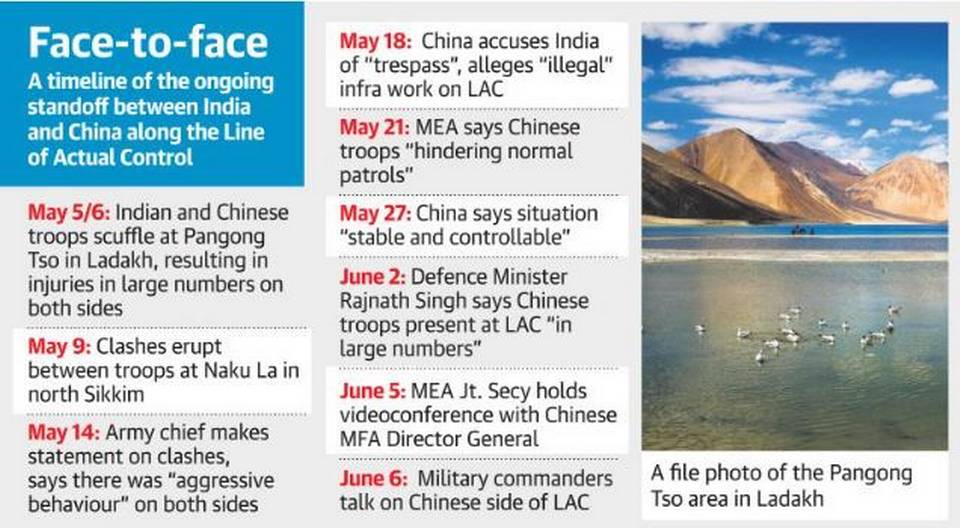
- Tensions between the two sides have continued for more than a month, and serious skirmishes were reported between the Indian Army and PLA soldiers at several points of the Line of Actual Control in Ladakh and Sikkim.
- China is understood to have made significant incursions, and the Indian Army has also bolstered its positions.
Click Here to read more about the standoff and border dispute
-Source: The Hindu
DUE TO LOCKDOWNS CENSUS-NPR MAY BE PUSHED TO 2021
Focus: GS-II Governance
Why in news?
- As Census houselisting and NPR operations remain suspended on account of Covid-19, an assessment may need to be taken to assess if the entire exercise be rescheduled for 2021.
Highlights
- Census 2021 is to be held in two phases — Phase 1 covering houselisting and housing, to be conducted along with the National Population Register (NPR) exercise followed by population enumeration.
- In view of lockdowns, rescheduling of Census dates is necessary for maintaining operational sanctity and convenience to ensure the integrity and acceptability of the demographic data, since it is an exercise with huge statutory implications.
What is the National Population Register (NPR)?
- The NPR is a database of usual residents in the country who have stayed in a local area for the past six months or more and who intend to remain in the same place for the next six months or more.
- The NPR is individual and identity specific unlike the Census which only provides information on the status of the residents of India and population swings.
- The NPR database was first created in 2010.
- The data collection is done under the aegis of the Office of the Registrar General and Census Commissioner of India.
- The NPR is undertaken under the provisions of The Citizenship Act, 1955 and The Citizenship (Registration of Citizens and issue of National Identity Cards) Rules, 2003.
- The NPR was last updated, except in Assam and Meghalaya, in 2015-16.
Census (With Prelims Bits)
- The census provides information on size, distribution and socio-economic, demographic and other characteristics of the country’s population.
- The first synchronous census in India was held in 1881, and since then, censuses have been undertaken uninterruptedly once every ten years.
- India’s last census was carried out in 2011 when the country’s population stood at 121 crores.
- The Census 2021 will be conducted in 18 languages out of the 22 scheduled languages (under 8th schedule) and English, and the option of “Other” under the gender category will be changed to “Third Gender”.
- For the first time data is proposed to be collected through a mobile app by enumerators and they will receive an additional payment as an incentive.
- The last caste-based census was conducted by the British in 1931.
- Arthashastr by ‘Kautilya’ written in the 3rd Century BC prescribed the collection of population statistics as a measure of state policy for taxation.
-Source: Times of India
PLANS AFOOT FOR INDIA’S 1ST COAL EXCHANGE
Focus: GS-III Indian Economy, Industry and Infrastructure
Why in news?
India has taken a step towards completely throwing open the Coal sector to market forces as the country gears up for commercial coal mining auctions, which will increase the number of sellers of coal.
Details of the Proposal and Impact
- As per the proposal, entire coal produced in the country will be traded on a ‘Coal Exchange,’ an online platform where pricing is determined transparently through demand and supply.
- The exchange is being thought out on the lines of commodity exchanges, power bourses or the proposed gas exchange.
- This could mean the end of new Fuel Supply Agreements (FSA) regime of Coal India where the state-run miner signs contracts for coal supply with consumers.
- Coal blocks have also been allotted to state PSUs for sale of coal.

Reducing Dependence on Imports
- The country’s coal import dropped by 20% in May 2020, industry data showed.
- The government is planning to bring the country’s ‘avoidable coal imports’ to zero by 2023-24.
- Demand for coal import is expected to remain subdued in the short-term given the high coal stock levels in pithead and power plants
India’s Coal Imports
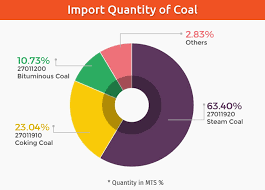
- Coal is among the top five commodities imported by India, the world’s largest consumer, importer and producer of the fuel.
- India imported 51.33 million tonnes of coking coal in 2019, down from 51.63 million tonnes in 2018, the data showed.
- Import Quantity Of Coal 283%
- Imports of thermal coal — mainly used for power generation — jumped 12.6% to 197.84 million tonnes in 2019.
- However, imports of coking coal — used mainly in the manufacturing of steel — fell marginally, following two straight years of increase, government data showed.
-Source: Economic Times




